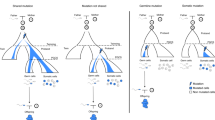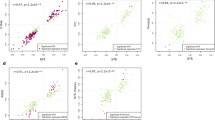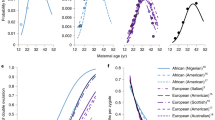Abstract
It is generally assumed that the identity of the genotype explains why there is less difference between monozygotic than between dizygotic twins. But monozygotic twins are also exposed to identical non-genetic influences, which act on the common zygote until the time of separation into the two twin partners. We have studied such influences by comparing genetically identical monozygotic and dizygotic mouse twins transplanted into foster mothers at the 8-cell stage. We show that monozygotic twins have a greater degree of similarity than genetically identical dizygotic twins. This suggests that the differences between dizygotic twins may be due in part to non-genetic influences on the zygote as far as the third cleavage stage.
This is a preview of subscription content, access via your institution
Access options
Subscribe to this journal
Receive 51 print issues and online access
$199.00 per year
only $3.90 per issue
Buy this article
- Purchase on Springer Link
- Instant access to full article PDF
Prices may be subject to local taxes which are calculated during checkout
Similar content being viewed by others
References
Deol, M. S. & Grüneberg, H. Genet. Res. 1, 50–88 (1960).
Hedrich, H. J., Rapp, K., Zschege, C. Z. Versuchstierk. 17, 263–274 (1975).
Festing, M. Inbred Strains in Biomedical Research (Macmillan, London, 1979).
Hedrich, H. J. in The Mouse in Biomedical Research Vol. 1. (eds Foster, H. L., Small, J. D. & Fox, J. G.) 159–176 (Academic, New York, 1981).
Nimierko, A. & Opas, J. Methods in Mammalian Reproduction (Academic, New York, 1978).
McLaren, A. J. Reprod. Fert. 19, 341–346 (1969).
Whitten, W. K. Adv. Biosci. 6, 129–141 (1971).
Hogan, B. & Tilly, R. Nature 265, 626–629 (1977).
McLaren, A. J. exp. Biol. 33, 394–416 (1956).
Weber, E. Grundriβ der Biologischen Statistik 7th edn, Ch. 37, 268–270 (VEB Gustav Fischer, Jena, 1972).
Falconer, D. S. Introduction to quantitative genetics (Oliver & Boyd, Edinburgh and London, 1960).
Grüneberg, H. The Pathology of Development (Blackwell, Oxford, 1963).
Author information
Authors and Affiliations
Rights and permissions
About this article
Cite this article
Gärtner, K., Baunack, E. Is the similarity of monozygotic twins due to genetic factors alone?. Nature 292, 646–647 (1981). https://doi.org/10.1038/292646a0
Received:
Accepted:
Issue Date:
DOI: https://doi.org/10.1038/292646a0
This article is cited by
-
A self-organization framework for symmetry breaking in the mammalian embryo
Nature Reviews Molecular Cell Biology (2013)
-
The myth of genetic enhancement
Theoretical Medicine and Bioethics (2012)
-
Epigenetics as a unifying principle in the aetiology of complex traits and diseases
Nature (2010)
-
DNA methylation profiles in monozygotic and dizygotic twins
Nature Genetics (2009)
-
Retrotransposons as epigenetic mediators of phenotypic variation in mammals
Nature Genetics (2001)
Comments
By submitting a comment you agree to abide by our Terms and Community Guidelines. If you find something abusive or that does not comply with our terms or guidelines please flag it as inappropriate.



